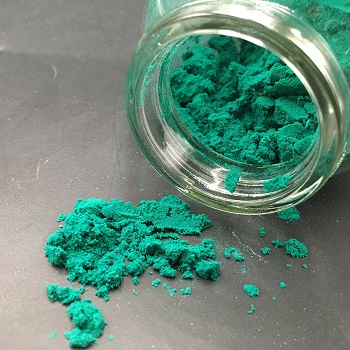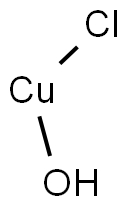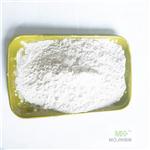Copper oxychloride, or dicopperchloridetrihydroxide, Cu2(OH)3Cl, [1332- 65-6], MW 213.56 MP (dec) 200°C, d 3.723.76, occurs in nature as the green, hexagonal paratacamite or the rhombic atacamite mineral. It is known as basic copper chloride or copper oxychloride in commerce and the usual formula assigned as CuCl2·3Cu(OH)2. The material is essentially insoluble in water but dissolves readily in mineral acids, formic acid, and warm acetic acid or complexing media such as solutions of ammonia or alkali metal cyanide. In sodium hydroxide solution, the blue copper(II) hydroxide is formed which, upon heating, converts to copper(II) oxide.Copper oxychloride is a green powder used as blue color agent, is a basic copper chloride and is usually manufactured either by the action of hydrochloric acid on copper metal or by the air oxidation of cuprous chloride suspensions.
It has a number of applications, by far the most important being as an agricultural fungicide, for which purpose it is extensively employed in formulated form as dusts, wettable powders and pastes.

Copper oxychloride (3Cu (OH)2.CuCl2) is a fungicide used at 2.50g/L against early and late blight in potato crops.
Copper fungicides have been used to protect crops after the 'accidental' discovery of the Bordeaux mixture by Pierre-Marie-Alexis Millardet in the late 1800s.
Copper oxychloride is a fungicide that controls a wide range of fungal and bacterial diseases on fruit, vegetables and ornamentals protecting the plant.
Copper oxychloride is used as an agricultural fungicide and as a colorant for glass and ceramics and in pyrotechnics.
Copper oxychloride is also produced by hydrolysis of copper(II) chloride solutions at pH's of 47. Various alkali can be used such as sodium carbonate (Agal'tsov et al., 1982) or ammonium, calcium, or sodium hydroxides (Feitknecht and Maget, 1949). The reaction with sodium hydroxide can be represented by.
4CuCl2 + 6NaOH → CuCl2.3Cu(OH)2 + 6NaCl
broad spectrum copper spray that controls a wide range of fungal and bacterial diseases. Ingredients 500g/kg copper as copper oxychloride in the form of a wettable powder.
avoid spraying in hot sunshine. Copper oxychloride will stain on contact with walls, fences and other surfaces.Compatible with most other pesticides except lime sulphur.
Bluish-green powder. Odorless
Used to control fungi on beets, fruit crops, grapes, olive trees, potatoes, vegetables, tomatoes, ornamental plants, and many more. Used as a bird repellant
UN3077 Environmentally hazardous substances, solid, n.o.s., Hazard class: 9; Labels: 9-Miscellaneous hazardous material, Technical Name Required.
When heated to decomposition or on contact with acids or acid fumes, may produce highly toxic chloride fumes and deadly phosgene gas. May cause pitting of some metals
Copper-containing wastes can be concentrated through the use of ion exchange, reverse osmosis, or evaporators to the point where copper can be electrolytically removed and sent to a reclaiming firm. 916 Copper Oxychloride Details of copper recovery from a variety of industrial wastes have been published. If recovery is not feasible, the copper can be precipitated by the use of caustics and the sludge de posited in a chemical waste landfill. Recommendable methods: Precipitation, solidification, landfill, discharge to sewer, & incineration. Peer-review: Precipitate copper with alkali, filter, solidify precipitate. (Do not use ammonia as alkali). Cation exchange will allow recovery of copper. Eluate from cation exchanger can be passed through anion exchanger to remove (or reduce) naphthenic acid content. Exhausted ion exchange resins can be landfilled. (Peer-review conclusions of an IRPTC expert consultation)




